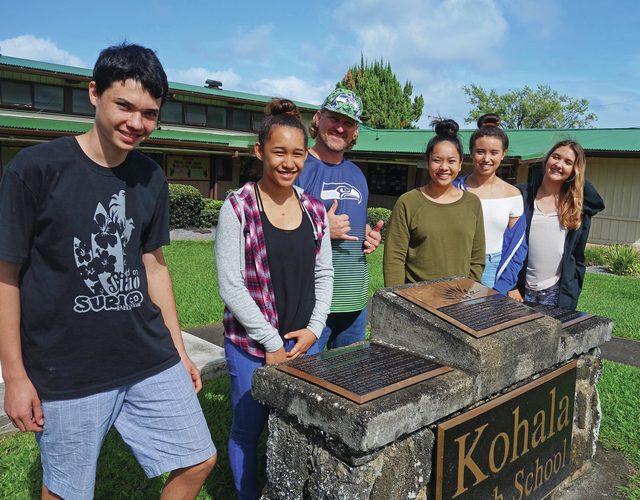KOHALA — Five Kohala teens have a good chance of winning $30,000.
KOHALA — Five Kohala teens have a good chance of winning $30,000.
Zaz Matsu, Naomi Ney, Nicole Castillo, Maya Anderson and Duncan Anderson are part of Kohala High School’s Kohala Ocean Clean-up Crew. Formed in September as part of the school’s new AP environmental science class, the ambitious students shortly thereafter entered The Lexus Eco Challenge – a national STEM competition for grades 6–12 in which student teams tackle environmental issues related to land, water, air and climate, and create practical solutions.
In the first phase of the competition, the students set a lofty goal: helping to reverse the flow of small non-biodegradable plastics, known as micro-plastics, into the ocean where fish, birds and planktons consume them.
To create a plan, on Sept. 10 they went to Pololu Valley for several hours, returning with 200 pounds of marine debris. They then educated the community on this problem by creating a mural made of plastic pollutants.
“We saw a lot of Styrofoam down there — more than anything we’ve seen before,” Castillo said. “You have to actually look for the plastics or you can’t see them. The whole beach is covered in plastics.”
They then presented a recycling plan to the Hawaii Island Packaging Sustainability Initiative Stakeholders task force and Hawaii County Environmental Management Committee on Oct. 4 with a recommendation to add compostable plastic stations to the new County compost facility in Hilo that is expected to open in 2018. Currently, this is not a part of the county’s proposed plan.
“When these compostable plastics get thrown in with regular plastics, they release methane gas into the atmosphere and it causes global warming,” Ney said. “It’s been a big problem.”
The group also participated in the beach clean-up effort at Kamilo Beach in Kau, organized by Hawaii Wildlife Fund on Oct. 10, along with Christian Liberty School students. Five hundred pounds of marine debris was collected in several hours. One of the worst polluted beaches on the island, the crew plans to continue supporting cleanup efforts there.
“The green debris is from the Japan tsunami from 2010 that still has an impact on our island. It keeps showing up on our shores where the current comes in,” Matsu said.
Based on what they learned, the students made plastic ocean pollution their main focus in The Land &Water Challenge portion of the Eco Challenge. In late October, they won $10,000 as the prize.
In early November, the Crew submitted a three-prong entry for the final part of the challenge. The first project will be building two recycle stations — one at Kamehameha Park and the other at Keokea Beach — as a joint effort among Kohala schools. The crew was given $5,000 from the council to do so.
“Elementary and middle schools kids will help to decorate the stations that will also be an educational tool for the community, teaching them the right way to recycle, plastic pollution problems, danger to the wildlife and showing our love of our community,” said Hana Kuwabara Anderson, Maya and Duncan’s mother who has been involved since the beginning.
The environmental science students are also conducting research on microplastics identification in collaboration with scientists at UC Santa Barbara. The goal is to identify different types of polymers and recycle them accordingly.
“We decided to work with these scientists because my mom had a connection with them,” Maya said. “Once we collected all the microplastics from Kamilo Beach, we sent them to the lab and they tested their toxicity. With their technology, they used machines that sort the types of plastics and we ordered a smaller version of it that we will use here.”
Ney added, “When you collect sand in a tub and add water, all the plastic floats to the top. We need to know what’s most harmful, if we can downgrade the use of it on the island and ultimately measure the effect.”
As the third component of the project, the students want to educate Kohala citizens about recycling plastic waste. With the help of Marsha Hee of Recycle Hawaii and Megan Lamson at Hawaii Wildlife Fund, they will focus on the business community, such as plastics manufacturers, restaurants, stores and consumers. Duncan is currently creating brochures to help spread the word.
The crew plans to have all three parts of the project completed in January or early February. The winner of the $30,000 grand prize will be contacted by the end of February.
As if they weren’t busy enough, the crew has also applied to attend the International Youth Summit in March to be held in Dana Point, California. They created a video on plastics pollution that discusses the problem and their solutions. Students from around the world will attend and present their ideas.
“I always saw the plastics as a threat, but through the environmental science class I see the more detrimental effects they are causing on the environment,” Castillo said.
“I’ve always tried to be environmentally friendly but only recently have I realized the horrible effects plastic has on us,” Maya said. “Learning and studying about them and their toxic waste that we consume makes me want to make a difference.”
Matsu agrees.
“I didn’t even car e about plastics back in middle school but now looking at all these things I realize how bad things are. It’s really sad,” Matsu said.
Marcus Douglas, who teaches the students’ environmental science class, added, “My role was to get them knowledgeable for why their project is important.”

